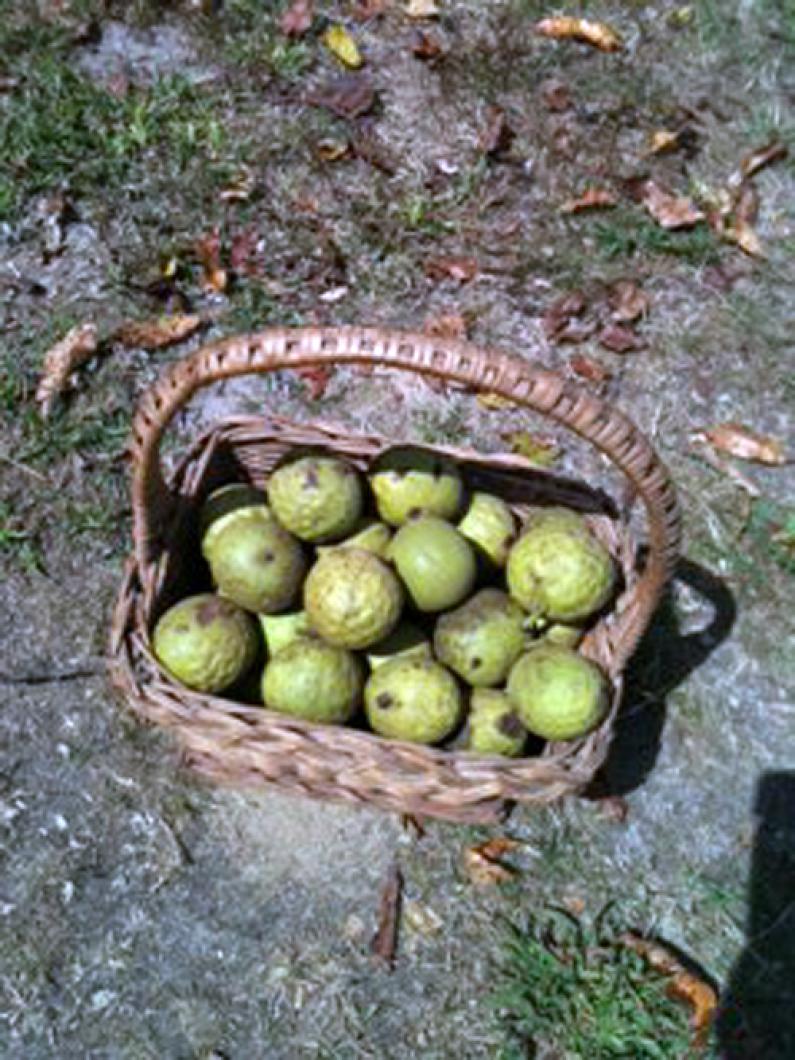Sometimes you feel like a nut, sometimes you don’t.
I always do and I enjoy eating them too; there isn’t a nut around that doesn’t entice me. Hurricane Irene gave me and other nut lovers a gift of glut: nut glut.
Though the high winds toppled some trees, my black walnut tree held on straight and tall. What it did give up to the gusts was an early crop of nuts. Usually one must wait till later in the fall to harvest black walnuts.
I collected basketfuls of the green-hulled nuts as quickly as possible, to beat out the competition. My main rival for the nutritious windfall was the squirrels, who are their chief pilferers. Deer and birds also will nibble but are not serious contenders.
Once collected, the difficult effort of extracting the nut ensues. Removing the husk is more dirty than challenging. A dye found in the nut’s husk is so potent that one must use gloves to remove the outer layer or have dyed hands for days. Once the husk is off, the hard work begins. Crushing the nut shell can be accomplished in many ways, but using a nutcracker is not a method that works.
The shell is so hard that the most commonly recommended method of extraction is driving a car over them! I prefer the bag-and-hammer method of putting the nuts in a bag and hammering the hell out of ’em. It works and saves my tires. Next, the tedious labor of removing the nut meat remains. Summer is over, so I expect to have some time (along with that dye) on my hands for this project.
Though not immediate gratification, such a project is well worth the effort. Black walnut meats are a coveted wild edible. They are somewhat scarce and boast a flavor five times stronger than the commercial walnuts sold in grocery stores. That variety is the Persian or English walnut, also called Carpathian walnut, and is one of more than 400 cultivars of black walnuts worldwide.
Black walnuts, Juglans nigra, are our native walnuts. Also called Eastern or American walnuts, they are prized for their bountiful harvest and copious uses. Early American settlers utilized the brownish/black dye to color cloth and even their own hair. Wood from the black walnut was employed to make gunstocks, furniture, flooring, paddles and even coffins that would provide eternal rest in walnut wood.
The nut shells, too, were put into service when needed. It was reported that “During World War II, airplane pistons were cleaned with a ‘nut shell’ blaster and this idea was carried into the auto industry; manufacturers used shells to deburr precision gears. Ground shell products are also used to clean jet engines, as additives to drilling mud for oil-drilling operations, as filler in dynamite, as a nonslip agent in automobile tires, as an air-pressured propellant to strip paints, as a filter agent for scrubbers in smokestacks, and as a flourlike carrying agent in various insecticides.”
Clearly, black walnut shells did a lot of the heavy lifting in our industrial society, so I shouldn’t mind the work it will take to separate the sweet meat from the shells. And I suppose I should have a little extra, grudging admiration to spare, too, for squirrels, that have no problem getting the goods!
So no matter how you look at it — through an industrial lens, a squirrel’s eye, or as food for thought, we can all be happy that there will be fewer nuts about which to worry this season.
Suzan Bellincampi is director of the Felix Neck Wildlife Sanctuary in Edgartown.




Comments
Comment policy »